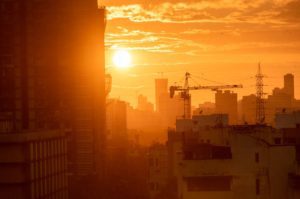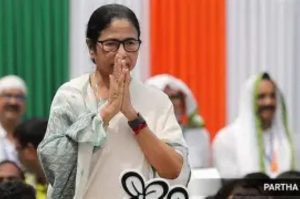Kolkata Parade Chaos: Kolkata’s Independence Day celebrations at the historic Red Road were meant to showcase patriotism and pride, but the soaring August heat turned the festive occasion into a medical emergency. Several schoolchildren and cadets, who were part of the parade, collapsed due to extreme heat and humidity during the morning function. The incident drew significant public concern, prompting Chief Minister Mamata Banerjee to make an unscheduled visit to SSKM Hospital, where the affected students were rushed for treatment.
Doctors confirmed that the children had suffered from dehydration, exhaustion, and mild heatstroke, conditions exacerbated by their long exposure under the blazing sun. The Chief Minister personally interacted with the families of the admitted children and assured them that all medical costs would be covered by the state. She emphasized that “no child should suffer in the spirit of duty” and instructed hospital authorities to ensure specialized monitoring for every patient.
Learn about heat safety guidelines here.
The Heat Factor: A Growing Risk in Kolkata
Kolkata has been battling prolonged bouts of heat and humidity this monsoon, with temperatures consistently hovering around 34–36°C and relative humidity levels often crossing 80%. For schoolchildren who had assembled since early morning in full ceremonial attire, the risk of dehydration was inevitable. Meteorologists from the India Meteorological Department (IMD) noted that even though the maximum temperatures were not record-breaking, the high moisture content in the atmosphere created a “feels-like” temperature of nearly 42°C during the parade.

Health experts have repeatedly warned about the dangers of conducting large-scale public events without adequate heat preparedness, especially in a climate-vulnerable city like Kolkata. They argue that lack of shaded enclosures, limited drinking water facilities, and the extended duration of the program were major contributors to the incident. Many parents have since questioned why children were required to stand for long hours in such weather conditions. Authorities, however, maintained that adequate medical teams were on standby and immediate intervention ensured there were no fatalities.
More on IMD weather bulletins.
CM’s Hospital Visit and Government’s Response
The Chief Minister’s prompt visit to SSKM Hospital highlighted the seriousness with which the state is treating the incident. Mamata Banerjee met with senior doctors, enquired about each student’s health condition, and directed hospital administrators to keep dedicated wards ready in case of further emergencies. She also announced that the government would issue a fresh set of Standard Operating Procedures (SOPs) for future public events involving children, particularly parades and cultural performances in open-air environments.


Political observers see this as an attempt to project empathy and accountability, given that large-scale events often draw criticism when mishandled. In her media briefing outside the hospital, the Chief Minister stated: “Our students are our pride, and their safety is paramount. We will review protocols to ensure such incidents are not repeated.” Meanwhile, state education officials have been tasked with consulting health experts to design child-friendly participation models for national events. Sources indicate that the new SOPs may include provisions for shaded stands, compulsory hydration breaks, and shorter parade durations for students under 15 years of age.
SSKM Hospital official updates.
Public Sentiment and Political Debate
While relief spread after doctors confirmed that the affected children were stable, the incident quickly escalated into a subject of public debate. Parents took to social media platforms, voicing both gratitude for the CM’s quick intervention and criticism over what they termed “avoidable exposure.” Several users questioned whether symbolic displays of patriotism should come at the cost of children’s health. Political opponents of the ruling
Trinamool Congress seized the opportunity to accuse the government of “poor planning.” Leaders from opposition parties demanded accountability, arguing that event organizers should have anticipated the weather conditions and adjusted the schedule accordingly. Some even suggested holding parades indoors or during cooler evening hours in the future. The debate has reignited broader conversations about Kolkata’s preparedness for climate-linked challenges.
Experts point out that the incident is not an isolated one; similar cases of schoolchildren fainting during Republic Day and Independence Day functions have been reported in the past. The tragedy lies not in the symbolism of the event but in the failure to prioritize health and safety alongside tradition.
Public health perspectives on extreme weather.
Kolkata Parade Chaos: Climate Change and Future Preparedness
What happened at the Red Road parade is more than a one-day mishap; it reflects Kolkata’s ongoing battle with climate change. The city, surrounded by rivers and close to the Bay of Bengal, experiences prolonged humid spells that intensify heat stress. Scientists warn that urban heatwaves will become more frequent and severe in the coming decades. In such a scenario, public gatherings, especially involving vulnerable groups like children and the elderly, require restructured safety measures. Urban planners argue that event design must now include heat-mitigation elements like green canopies, mist fans, and portable water distribution systems.
Lessons can also be drawn from international examples, where schools and parades adjust schedules around weather forecasts. Moreover, Kolkata’s healthcare infrastructure must be prepared for climate-induced emergencies, ensuring that hospitals have the capacity to handle sudden influxes of patients during civic events. The Chief Minister’s directives for new SOPs could mark the beginning of a systemic change if implemented sincerely. For now, the incident serves as both a warning and an opportunity—to rethink how public celebrations can adapt to a warming planet without compromising cultural pride.
Also read: Home | Channel 6 Network – Latest News, Breaking Updates: Politics, Business, Tech & More

